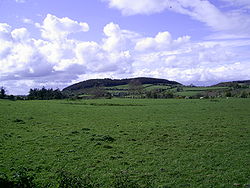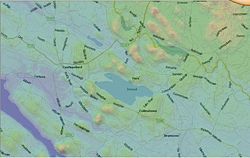
Ranaghan
Encyclopedia




Introduction
A townland south-west of Lough LeneLough Lene
Lough Lene is a lake situated in north County Westmeath, Ireland, between the villages of Castlepollard, Collinstown and Fore....
positioned on high ground where there are a multitude of ringforts, Randoon
Randoon
Randoon is a Turgesius Viking fortress located southwest of Lough Lene. The fortress is situated upon a hill in Ranaghan, dominating by its height all other ringforts in the area, and overlooking Lough Lene between the town of Castlepollard and Collinstown. The locally used term fort refers to any...
possibly the most famous fort of the area , is situated between Castlepollard
Castlepollard
Castlepollard is a large village in north County Westmeath, Ireland. Located in the barony of Demifore, in the civil parish of Rathgarve, it lies west of Lough Lene and northeast of Lough Derravaragh and Mullingar.-Name:...
and Collinstown
Collinstown
Collinstown is an expanding village in County Westmeath, situated on the R395 regional road 18 km northeast of the county town of Mullingar. Collinstown is in St Mary's parish and has a population of approaching 700.-Name:...
. Turgesius the Viking
Viking
The term Viking is customarily used to refer to the Norse explorers, warriors, merchants, and pirates who raided, traded, explored and settled in wide areas of Europe, Asia and the North Atlantic islands from the late 8th to the mid-11th century.These Norsemen used their famed longships to...
is believed to govern and sejourne in this area.
Origins
Ringforts are fortified settlements that are generally agreed to be from the Early Medieval Period in Northern Europe, especially Ireland. They are also known as ráth, (as in Ranaghan) caiseal, cathair and dún (as in RandoonRandoon
Randoon is a Turgesius Viking fortress located southwest of Lough Lene. The fortress is situated upon a hill in Ranaghan, dominating by its height all other ringforts in the area, and overlooking Lough Lene between the town of Castlepollard and Collinstown. The locally used term fort refers to any...
) in the early Irish sources. A ráth (anglicised rath), was made of earth, caiseal (northwestern Ireland, anglicised cashel) and cathair (southwestern Ireland) were built of stone. A dun is a more prestigious site, the seat of some kind of local chieften or ruler, the term is applied to promontory forts as well.
Locations
No historical or archaeological maps, surveys, nor records of the Early Medieval Period in Ireland approach the dates of the Irish ringforts. Area surrounding Lough Lene (meaning fertile soil) of CollinstownCollinstown
Collinstown is an expanding village in County Westmeath, situated on the R395 regional road 18 km northeast of the county town of Mullingar. Collinstown is in St Mary's parish and has a population of approaching 700.-Name:...
, Glenidan, Comerstown, Ranaghan, are areas doted with a multitude of ring forts testifying to the land of fertile soil.
External links
See also
- Ringforts
- Hill of TaraHill of TaraThe Hill of Tara , located near the River Boyne, is an archaeological complex that runs between Navan and Dunshaughlin in County Meath, Leinster, Ireland...
- Grianan of AileachGrianan of AileachThe Grianán of Aileach is a group of historic monuments in County Donegal, Ireland built on the hill of Grianán which is 244 metres high. Most writers have identified the site as being the great “royal fort” of Aileach...
- TurgesiusTurgesiusTurgesius was a Viking chief active in Ireland who is said to have conquered Dublin. It is not at all clear whether the names in the Irish annals represent the Old Norse Thurgestr or Thorgísl...
- Lough LeneLough LeneLough Lene is a lake situated in north County Westmeath, Ireland, between the villages of Castlepollard, Collinstown and Fore....
External links
- The Modern Antiquarian: Website containing further information
- Megalithic: Website containing a Layout and Description
Raftery, Barry, ‘Irish Hillforts’ in Charles Thomas (ed.), The Iron Age in the Irish Sea Province (London, 1972).
- The Iron Age in the Irish Sea Province (London, 1972).
- Stout, Matthew, The Irish Ringfort (Dublin, 1997).

